Restorative Justice Strategies for School Counselors and Educators: 5 Steps to Build Trust, Connection, and Reduce Student Conflicts
- Monique McNamara
- Aug 26
- 11 min read
The start of a new school year always has its own kind of magic. There’s the hum of possibility in the air, fresh notebooks waiting to be filled, pencils sharpened and ready, and plenty of chances to set a positive tone for the months ahead.
For school counselors, this isn’t just a date on the calendar. It’s a chance to press reset and set the stage for how the year will feel, look, and flow.
Of course, the start of the year can be a lot. You’re meeting brand new faces, checking in with familiar ones, handling teacher requests, and juggling what can feel like a hundred tiny fires. The pressure to “fix” things quickly is real.
This is exactly where Restorative Justice (RJ) comes in. Instead of piling more onto your plate, it gives you a structure that supports you, builds stronger connections, and helps prevent the same issues from popping up again and again.
Think of RJ as your pause and breathe button. It stops the knee-jerk reaction and gives you a process to lean on, one that invites understanding, repair, and real learning. You don’t have to rely on quick fixes or gut instinct alone. You can count on a clear framework that builds trust and teaches students skills they’ll use for life.
When you start the year with RJ, you’re doing more than making rules. You’re sending a message: mistakes are part of growing, and there will be space to make things right. That one shift can ripple through your whole school, creating a more supportive, respectful, and connected environment for students, staff, and families.
Why RJ Belongs in Every Counselor’s Toolbox
Restorative Justice isn’t just another “behavior management” tool. It’s a mindset that fits perfectly with what you already do as a counselor: connect, listen, and help students grow into their best selves. It gives you something solid to lean on during those tricky moments when feelings run high and relationships feel strained.
Instead of jumping straight to blame, RJ leads with curiosity. Bringing students into a restorative conversation gives them space to tell their side and, just as importantly, to hear someone else’s. That simple act of listening and being heard can shift the whole dynamic.
You can also explore more ways to foster a restorative school culture in our post: Creating a Supportive School Environment with Restorative Justice.
Over time, students start showing up to these conversations with more openness and empathy.
RJ also makes your role a little lighter. It gives you a shared language with teachers, administrators, and parents so you’re not left inventing solutions on the fly. Everyone knows the process, and that shared understanding means fewer misunderstandings and more realistic expectations.
When the whole school leans into RJ, something changes. Discipline becomes something we do with students, not to them. Trust grows. Belonging deepens. Even students who’ve struggled to connect start feeling like they have a place here. Over time, you see fewer repeat conflicts, more respectful interactions, and a school culture you’re proud to be part of.
Laying the Groundwork for a Restorative School Culture
Creating a restorative culture starts with intentional choices in those first few weeks of school. These aren’t just “nice extras”, they’re the foundation for building a community where students feel safe, valued, and empowered to repair harm when it happens.
Here’s how to set that foundation at a school-wide level:
Introduce restorative language early and consistently
From day one, collaborate with teachers and staff to use shared phrases like “repairing harm,” “making things right,” and “listening to understand.” This could happen during morning announcements, classroom visits, or even printed in welcome packets. The more students hear these phrases, the more natural they become. Consistency across staff sends a powerful message that these values are for everyone, not just something “the counselor does.”
Design visible restorative spaces throughout the school
Work with teachers and administrators to set up areas where restorative conversations can happen in a calm, neutral environment. This might be a few chairs in a circle in a quiet corner of the library, a designated space in the counselor’s office, or a room that can be booked for restorative circles. Display visual cues like the Restorative Justice Posters so the space feels intentional and inviting.
Create and display shared agreements Lead a process where students, staff, and administrators co-create school-wide agreements for respectful behavior and conflict resolution. Keep them short, three to five points that can be remembered easily by all grade levels. Print them as large posters for hallways, include them in student planners, and revisit them in staff meetings and assemblies to keep them alive in daily practice.
Embed restorative practices in school events
Look for moments in the school calendar to weave in restorative elements. This could be a five-minute check-in circle during morning meetings, a reflection circle at the end of a school assembly, or a gratitude-sharing round before a school break. These short, consistent touches normalize restorative practices beyond conflict situations.
Model restorative leadership
As a counselor, you set the tone for how conflicts are addressed. Let students and staff see you listening without interrupting, asking thoughtful questions, and acknowledging emotions before moving toward solutions. When students observe you handling difficult conversations with respect and empathy, they begin to mirror those skills in their own interactions.
Small, school-wide changes like these lay the groundwork for a culture where restorative conversations are natural, expected, and welcomed, not just something reserved for “big” conflicts. Over time, these consistent choices become part of your school’s identity.
Bringing RJ to Life with the Restorative Justice Bundle
If you want to make RJ part of your everyday counseling work without piecing together resources from all over, the Restorative Justice Bundle gives you everything you need in one place.
What’s inside:
26 Restorative Justice Worksheets – Thoughtfully designed prompts and think sheets that guide students through reflection after a conflict. They help students consider what happened, who was affected, and how they can make things right. Flexible enough for individual use, small groups, or as part of a larger restorative process.
Restorative Justice Circle Questions & Prompts – Ready-to-use conversation starters that keep discussions focused and meaningful. Whether in a one-on-one meeting or a full circle, they help everyone feel heard and guide the group toward a constructive resolution.
Conflict Resolution Cards – Perfect for role-play and skill-building exercises. These cards present realistic scenarios that invite students to practice resolving disagreements in positive ways while encouraging creativity, empathy, and critical thinking.
Social Skills Board Game – An engaging and interactive way to teach core social skills. Players move through the game by answering prompts, solving problems, or role-playing situations, all while practicing communication, empathy, and cooperation.
Restorative Justice Poster Bundle – Eye-catching visual reminders of restorative values and steps. Placing them around the school reinforces the language and expectations of a restorative culture, helping students and staff keep those principles front of mind.
Why the bundle works:
Saves planning time with ready-to-use materials so you can focus on connecting with students instead of creating resources from scratch.
Keeps your approach consistent across different situations, ensuring students have a familiar framework every time they engage in the RJ process.
Supports both proactive RJ work, like teaching empathy and social skills, and responsive work, such as resolving conflicts after they occur.
Encourages engagement through interactive tools that make learning hands-on and approachable for different learning styles.
Creates a cohesive restorative culture by giving you resources that align with each other, reinforcing the same language and values across every interaction.
Helps you maintain momentum throughout the year by giving you fresh, flexible tools that can be adapted to individual, small group, or whole-class settings.
Strengthens your professional confidence by ensuring you always have something purposeful and ready to go, no matter what situation walks through your door.
With the bundle, you have a complete, consistent framework that helps you create a restorative culture without reinventing the wheel. It makes the process feel natural, engaging, and supportive for every student while keeping you equipped and confident in your role.
Real-Life Scenarios that Show the Impact of RJ
Stories are powerful. They bring concepts to life and remind us that behind every “case” is a student who can grow and change.
Scenario 1: Building empathy after a fight Two eighth graders get into a heated argument that turns physical. Instead of heading straight for suspension, you bring them together in a restorative circle. Guided by prompts from the Restorative Justice Circle Questions & Prompts, they share their perspectives. One admits he felt disrespected, the other shares that he was embarrassed in front of friends. By the end, they agree to collaborate on a class project, using the 26 Restorative Justice Worksheets to track how they’re working together.
Scenario 2: Comforting parents while addressing bullying A sixth grader has been bullying a classmate. The student’s parents fear she will be labeled a “problem kid.” You reassure them by explaining the RJ process. In a circle with the student, her parents, the classmate, and his parents, feelings are shared openly. Using the Conflict Resolution Cards, they brainstorm ways to repair the harm. The victim’s parents feel heard, and the student begins making amends.
Scenario 3: Reducing repeated classroom disruptions A group of students often disrupt lessons. You introduce the Social Skills Board Game in a small group setting. As they play, they practice communication, turn-taking, and empathy. Over a few weeks, disruptions decrease and positive participation grows.
Scenario 4: Restoring trust after property damage A student damages school property. Using the 26 Restorative Justice Worksheets for guided reflection, they identify who was impacted and how to make amends. The Restorative Justice Poster Bundle is used as a visual reminder in the classroom to reinforce restorative values. The student repairs the harm and delivers a genuine apology at a class meeting.
Scenario 5: Strengthening peer relationships Two students who have had ongoing small conflicts meet in a circle. Using the Restorative Justice Circle Questions & Prompts, they openly discuss misunderstandings. Later, they participate in a session with the Social Skills Board Game to practice positive interaction. Their relationship improves over time.
These moments show that RJ isn’t just theory. It’s a hands-on, human-centered way to build understanding, repair harm, and create stronger school communities.
Overcoming Common Implementation Challenges
Even with the right tools, real life can get messy. Here are practical ways to navigate the most common hurdles while keeping your restorative approach intact.
Staff or admin resistance
Share a tiny win. Pilot one circle with a willing teacher and report back the outcomes.
Offer a short script to lower the barrier: “We use questions to understand impact, then students help plan repair.”
Keep visual language visible with the Restorative Justice Poster Bundle so colleagues can see the shared norms at a glance
Keeping circles on track
Set clear norms and use a talking piece.
Time box two rounds and preselect three prompts from the Circle Questions and Prompts.
Close with a consistent exit question, such as “What is one action you will take after today?”
Ensuring accountability without shame
Move from apology to action. Use the Restorative Justice Worksheets to document who was affected, what repair looks like, and by when.
Schedule a brief check in. Put a 2 week follow up on the calendar and review the plan together.
Managing time constraints
Use micro circles when needed. Ten minutes with two questions can be enough.
Warm up classes with one scenario from the Conflict Resolution Cards to practice skills proactively.
Build social skills in small lunch groups using the Social Skills Board Game.
Adapting for different ages
Younger students benefit from visuals and concrete choices. Lean on the posters and board game prompts.
Older students can handle deeper reflection. Pair circle prompts with written processing on the worksheets.
How to Start Using RJ Right Away
You don’t have to wait for a big rollout or a full staff training to start using Restorative Justice in your work. As a counselor, you can begin modeling and practicing RJ principles with students immediately, even if the rest of the school isn’t fully on board yet.
Here are practical steps you can start using tomorrow:
Start with one resource from the Restorative Justice Bundle
Pick just one tool, like the Restorative Justice Circle Questions & Prompts, and introduce it in a low-pressure setting, perhaps during a lunch bunch, a small group skills session, or a classroom activity where there’s no high-stakes conflict. This lets students get comfortable with the format before it’s needed for a serious issue. The more you use it in everyday situations, the more natural it will feel for everyone when tensions are higher.
Practice your RJ language until it’s second nature
Restorative conversations live and die by the way questions are asked. Practice saying things like “What happened?” and “Who was affected?” in a tone that’s warm, curious, and nonjudgmental. You might even role-play with a colleague or in front of a mirror to refine your delivery. This step sounds small, but it can make the difference between a student shutting down or opening up.
Create an “RJ Zone” in your office
Dedicate a space where students know restorative conversations happen. Stock it with Restorative Justice Worksheets, a talking piece, the Social Skills Board Game, and posters for quick visual reminders. When a student steps into this corner, they immediately understand they’re in a safe, solution-focused environment.
Pilot a circle process with one trusted colleague
Team up with a teacher or administrator to handle a manageable conflict using RJ from start to finish. Prepare participants, guide the conversation, and close with clear action steps. Then, debrief with your colleague about what worked and what could be improved. Documenting these early successes makes it easier to get buy-in from others later on.
Reflect and adjust after each use
Keep a quick journal or digital note after every restorative session. Jot down where students responded well, moments that shifted the tone, and ideas for next time. Over time, this becomes your personal RJ playbook, a resource you can return to whenever you feel stuck or want to refine your approach.
By starting small and focusing on what you can control, you’ll build confidence in RJ practices while planting seeds that can grow into a school-wide movement. Even without a formal rollout, your work can influence the culture in powerful ways.
Gentle Observation: To every school counselor working hard to balance connection, accountability, and the daily challenges of your role, remember that you do not have to do it all alone or invent every solution from scratch.
Restorative Justice offers you both structure and flexibility. It’s not about being perfect; it’s about creating a culture where repair and understanding are the default responses to conflict. Small, consistent steps, whether that’s using one worksheet, facilitating a short circle, or introducing restorative language, can build momentum that lasts all year.
You have the power to help students see themselves not just for their mistakes, but for their potential to grow. The Restorative Justice Bundle is here to support you with ready-to-use tools that make that work easier, more consistent, and more impactful.
Your presence, your listening ear, and your belief in students’ ability to change can ripple far beyond your office walls. You are building more than solutions, you are building a community.
Jemma (Gentle Observations Team)
P.S.
Therapy Resource Library members, your direct links are here:
P.P.S.
Not a member yet? Join the Therapy Resource Library and get instant access to these tools and hundreds more.
P.P.P.S.
You may also enjoy reading our related post: Creating a Supportive School Environment with Restorative Justice.



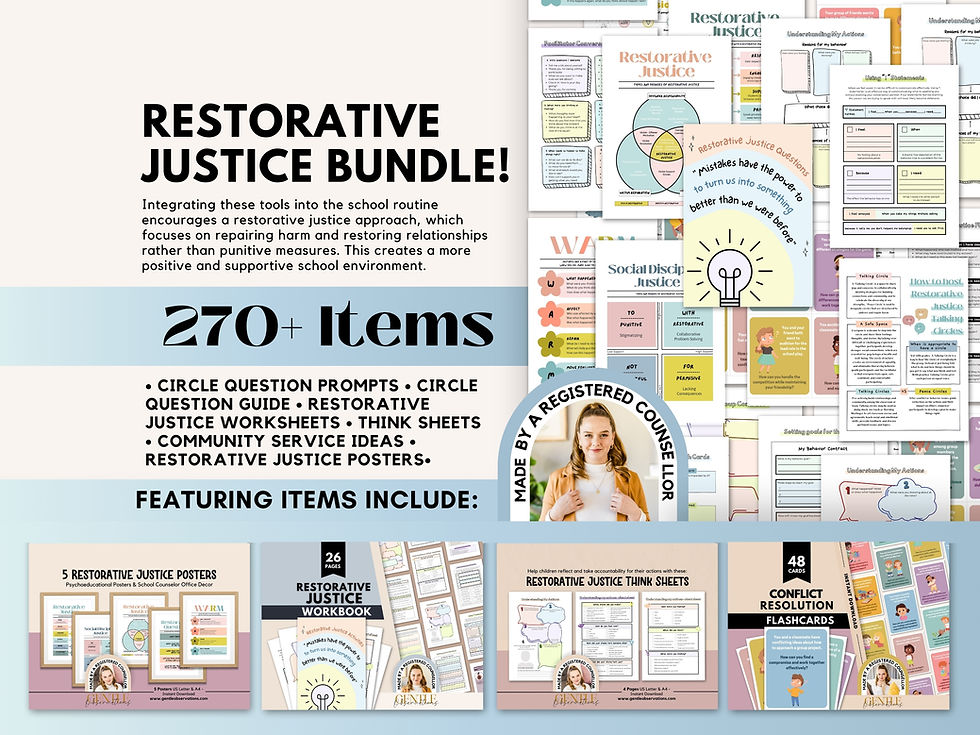
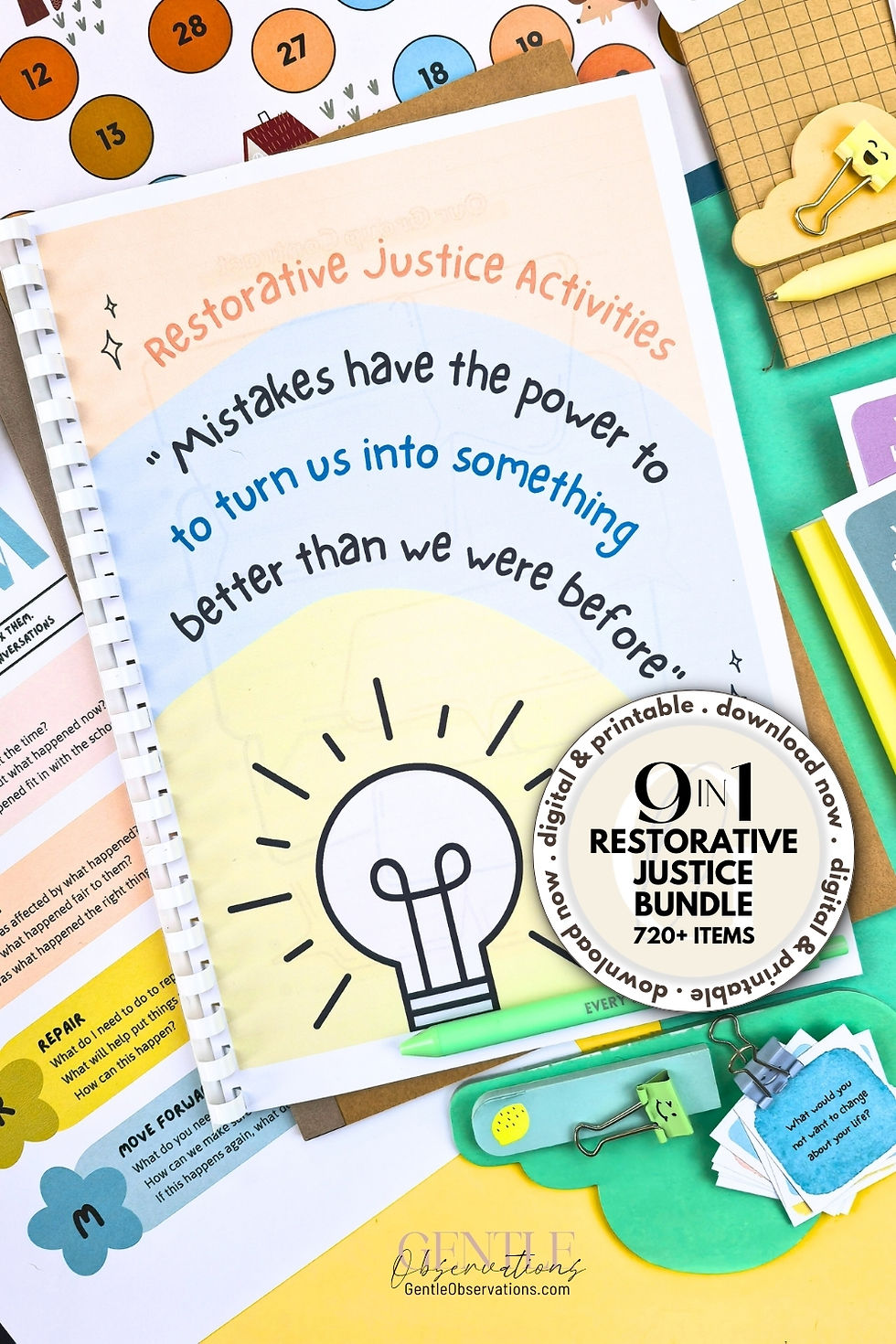



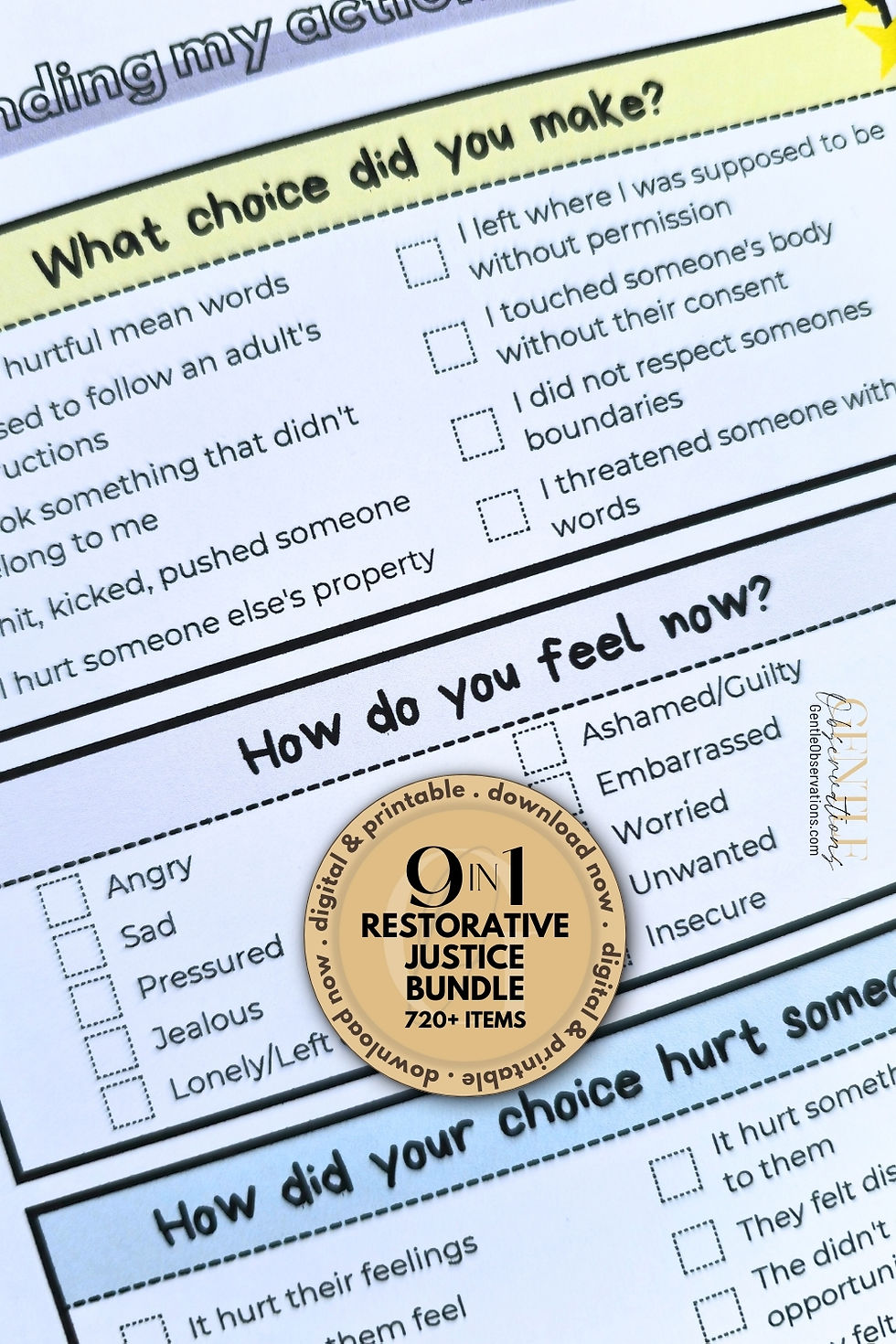



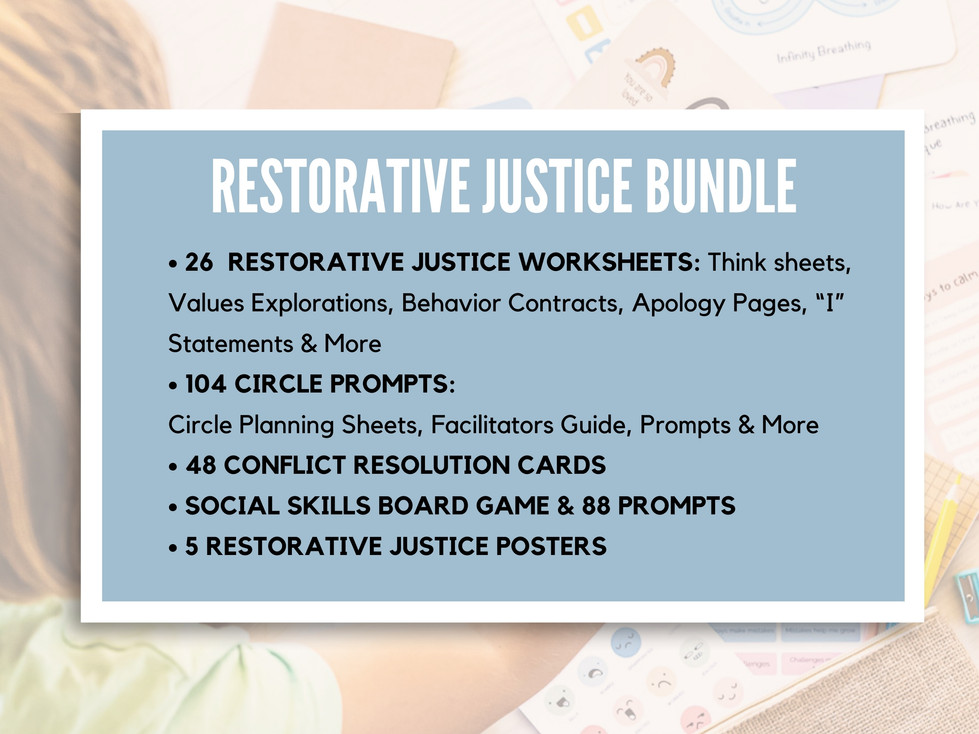









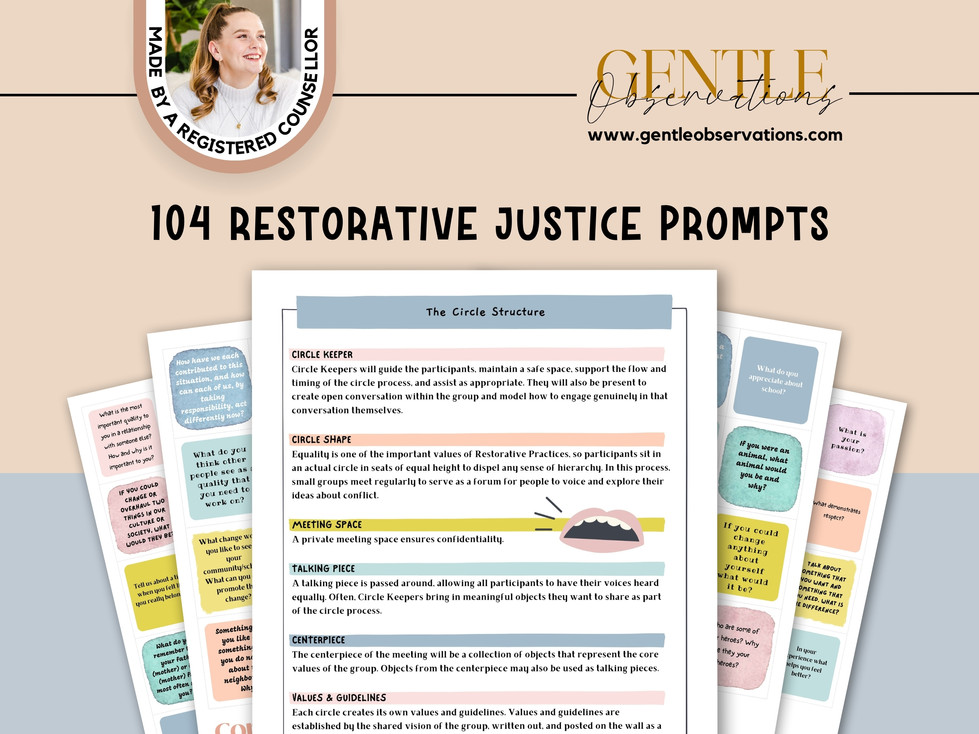



Comments